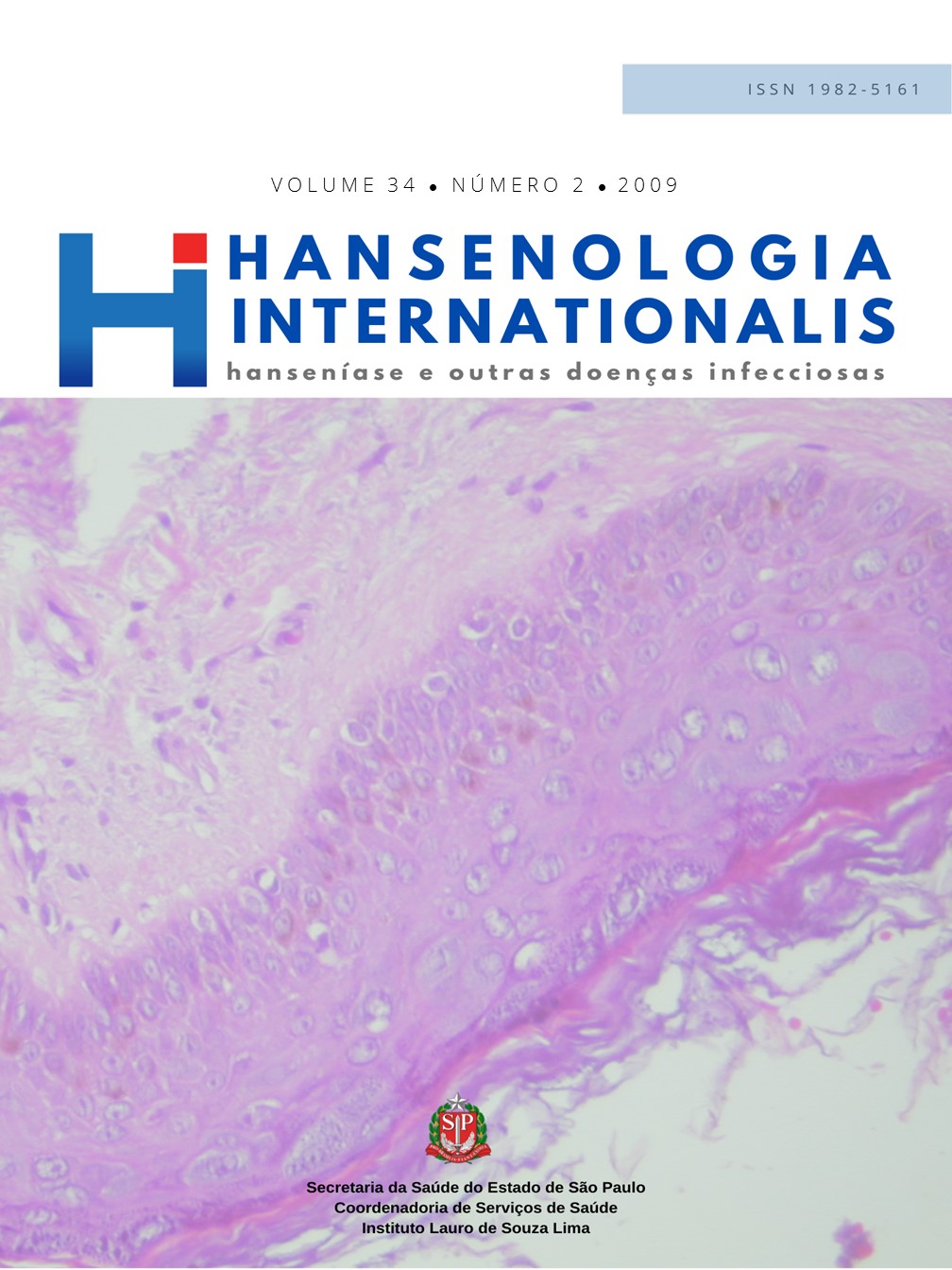Physical disabilities in Leprosy: Thing of the Past or Priority in Prevention?
DOI:
https://doi.org/10.47878/hi.2009.v34.36231Keywords:
Leprosy, physical disabilities, priorities in healthAbstract
Despite the relative scarcity of prospective studies on the subject, with the current expansion of the incidence of Hansen’s disease, its physical disabilities highlight increasing prominence, taking the personal and social meaning of these a step further, exacerbated by statements of even top religious authorities: The semantic therapy does not resolve if the ideology of the message remains. As a result, the implementation of preventive measures, diagnosis and treatment at the local unit, already fairly systematic in their respective technical aspects, is mandatory and essential. According to the World Health Organization, it is to implement measures, especially of: strengthening of programs, policies and national strategies for implementation of basic rules(for medical care, rehabilitation and support services), increase of greater awareness of the public on the importance of the issue of disabilities, as well as the coordination of all sectors of society to participate in activities to prevent disability; cooperation of state members in collecting more reliable data on relevant aspects. Such questions are the primary issues addressed in the present paper, from technical information available on the international expertise literature to the personal and professional experience of the authors.
Downloads
References
2 Ferreira J, Mengue SS, Wagner MB, Duncan BB et al. Esti2 mating hidden prevalence in Hansen’s Disease: through diagnosis delay and grade of disability at time of diagnosis. International Journal of Leprosy 2000; 68 (4): 464-473.
3 Lockwood DNJ, Kumar B. Treatment of leprosy: the evidence 3 base for newer drug combinations and shorter regimens is weak. British Medical Journal 2004; 328; 1447-1448.
4 Saunderson P. The epidemiology of reactions and nerve 4 damage. Leprosy Review 2000; 71 Suppl: S106-S110.
5 Meima A et al. Dynamics of impairment during and after 5 treatment: the AMFES cohort. Leprosy Review 2001; 72: 158-170.
6 Pimentel MIF, Nery JAC, Borges E, Gonçalves RR, Sarno EN6 et al. Impairments in multibacillary leprosy: a study from Brazil. Leprosy Review 2004; 75 : 143-152.
7 Saunderson P, Leekassa R. Reflections on the ILA African 7 Leprosy Congress. Leprosy Review 2005; 76: 108-111.
8 Schilder P. A imagem do corpo: as energias construtivas da 8 psique. São Paulo: Martins Fontes, 1999. 405 p.
9 Tavares MCGCF. Imagem corporal: conceito e desenvolvi9 mento. Barueri, SP: Manole; 2003 147p.
10 Freitas GG. O esquema corporal, a imagem corporal, a cons10 ciência corporal e a corporeidade. Ijuí:Unijuí; 2004. 96p.
11 Hegenberg L. Doença: um estudo filosófico. Rio de Janeiro: 11 Fiocruz; 1998. 137p.
12 Gonçalves A. Atividade Física: uma questão de Saúde Pública. 12 Revista Discorpo 2001; 11: 41-47.
13 Granda E, Breilh J. Saúde na sociedade. São Paulo: Abrasco; 13 1989. 161 p.
14 Goffman E. Estigma: notas sobre a manipulação da identida14 de deteriorada. Rio de Janeiro: LTC; 1988. 158p.
15 Rafferty J. Curing the stigma of leprosy. Leprosy Review 15 2005; 76: 119-126.
16 Heijnders ML. Experiencing leprosy: perceiving and coping 16 with leprosy and its treatment. A qualitative study conducted in Nepal. Leprosy Review 2004; 75: 327-333.
17 Kaur K, van Brakel W. Dehabilitation of leprosy-affected pe17 ople – a study on leprosy-affected beggars. Leprosy Review 2002; 73: 346-355.
18 Awofeso N. Concept and impact of stigma on discrimination 18 against leprosy sufferers - minimizing the harm. Leprosy Review 2005; 76: 101-102.
19 Brasil. Presidência da República. Disposição sobre a termi19 nologia oficial relativa à hanseníase e outras providências. Diário Oficial da União 9.010, 29-3-1995.
20 WHO. World Health Organization. Disability, including pre20 vention, management and rehabilitation. Fifty-eighth World Health Assembly. Disponível em: http://www.who.int/ gb/ebwha/pdf_files/WHA58/A58_17-en.pdf, 2005. Acesso em 26-7-2005.
21 WHO. World Health Organization. Disability, including 21 prevention, management and rehabilitation. Ninth plenary meeting. Fifty-eighth World Health Assembly. Disponível em: http://www.who.int/g/ebwha/pdf_files/WHA58/WHA58_23-en.pdf, 2005. Acesso em 26-7-2005.
22 Ilep. International Federation of Anti-leprosy Associations. 22 The ILA Technical Forum - Implications for Leprosy Control Programmes. ILEP Technical Bulletin 2002; 16.
23 Ilep. International Federation of Anti-leprosy Associations. 23 Report of the technical forum: implications for leprosy control programmes. Leprosy Review 2002; 73: S1-S62.
24 Heijnders ML. The dynamics of stigma in leprosy. Internatio24 nal Journal of Leprosy 2004; 72 (4): 437-447.
25 Kumar A, Girdhar A, Girdhar BK. Nerve thickening in leprosy patients and risk of paralytic deformities: a field based study in Agra, India. Leprosy Review 2004; 75: 135-142.
26 Berlinguer G. Medicina e Política. São Paulo: CEBES/HUCI26 TEC; 1978.
27 Brasil. Manual de prevenção de incapacidades. Brasília, Brasil: 27 Coordenação de Comunicação, Educação e Documentação-COMED/ASPLAN/FNS, 2001. 107 p.
28 Queiroz M, Carrasco MAP. O doente de Hanseníase em 28 Campinas: uma perspectiva antropológica. Cadernos Saúde Pública 1995; 11( 3): 479-490.
29 Pimentel MIF. Nery JAC, Borges E, Gonçalves RR, Sarno EN et 29 al. O exame neurológico inicial na hanseníase multibacilar: correlação entre a presença de nervos afetados com incapacidades presentes no diagnóstico e com a ocorrência de neurites francas. Anais Brasileiros de Dermatologia 2003; 78 ( 5): 561-568.
30 Smith WCS. Review of current research in the prevention of 30 nerve damage in leprosy. Leprosy Review 2000: 71 Suppl: S138-S144.
31 Croft RP, Richardus JH, Nicholls PG, Smith WC et al. Nerve 31 function impairment in leprosy: design, methodology and intake status of a prospective cohort study of 2664 new leprosy cases in Bangladesh (The Bangladesh Acute Nerve Damage Study). Leprosy Review 1999; 70: 140-159.
32 Smith WCS et al. Steroid prophylaxis for prevention of ner32 ve function impairment in leprosy: randomised placebo controlled trial (TRIPOD 1). British Medical Journal 2004; 328(7454): 1459-1462.
33 Ramos Jr ANR, Heukelbach J, Gomide M, Hinders DC, Schreu33 der PAM. Investigações em sistemas de serviços de saúde como ferramenta para o alcance de programas de controle da hanseníase mais efetivos no Brasil. Cadernos de Saúde Coletiva 2008; 16 (2): 147-168.
34 Pereira AJ, Helene LMF, Pedrazani ES, Martins CL, Vieira CSCA. 34 Atenção básica de saúde e a assistência em hanseníase em serviços de saúde de um município do Estado de São Paulo. Revista Brasileira de Enfermagem 2008; 61(esp): 718-726.
Downloads
Published
How to Cite
Issue
Section
License

This work is licensed under a Creative Commons Attribution 4.0 International License.
This journal is licensed under a Creative Commons Attribution 4.0 International License.


























